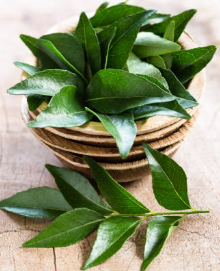The curry tree, scientifically known as Murraya koenigii, is a tropical to subtropical tree native to India and Sri Lanka. It is widely cultivated for its aromatic leaves, commonly known as curry leaves or Kadi Patta. While the leaves are the most commonly used part of the tree, other parts like the bark, roots, and berries also offer numerous health benefits. The curry tree is not just a culinary delight but also a powerhouse of nutrients and medicinal properties. In this blog, we’ll explore the incredible benefits of the curry tree, from its leaves to its roots, and why it deserves a special place in your life.

What Is the Curry Tree?
The curry tree is a small to medium-sized tree that belongs to the Rutaceae family. It is known for its fragrant, dark green leaves, which are widely used in Indian, Sri Lankan, and Southeast Asian cuisines. The tree also produces small, black berries that are edible but not as commonly used as the leaves. Every part of the curry tree – leaves, bark, roots, and berries – has been used in traditional medicine for centuries due to its therapeutic properties.
Nutritional Profile of the Curry Tree
The curry tree, especially its leaves, is packed with essential nutrients, including:
Vitamins: A, B, C, and E
Minerals: Iron, calcium, phosphorus, magnesium, and zinc
Antioxidants: Flavonoids, phenolic compounds, and carotenoids
Other compounds: Alkaloids, glycosides, and essential oils
These nutrients make the curry tree a natural remedy for various health issues and a valuable addition to your diet.
Benefits of the Curry Tree
1. Curry Leaves: The Most Popular Part
Curry leaves are the most widely used part of the curry tree. They are known for their distinct aroma and flavor, as well as their numerous health benefits:
a. Improves Digestion
Curry leaves stimulate digestive enzymes and improve gut health. They help relieve digestive issues like bloating, constipation, and indigestion. Chewing fresh curry leaves or drinking curry leaves boiled water can aid digestion.
b. Promotes Hair Health
Curry leaves are rich in antioxidants and amino acids, which strengthen hair follicles, prevent hair fall, and promote growth. Applying curry leaf oil or consuming curry leaves regularly can improve hair health.
c. Regulates Blood Sugar Levels
Curry leaves have hypoglycemic properties that help regulate blood sugar levels. They are particularly beneficial for people with diabetes or those at risk of developing the condition.
d. Boosts Immunity
Packed with vitamin C and antioxidants, curry leaves enhance your immune system and protect against infections.
e. Improves Skin Health
Curry leaves are rich in vitamin A and antioxidants, which promote healthy skin. They help reduce acne, blemishes, and signs of aging.
2. Curry Tree Bark: A Lesser-Known Remedy
The bark of the curry tree is often overlooked but offers several health benefits:
a. Anti-inflammatory Properties
Curry tree bark has anti-inflammatory properties that help reduce inflammation and pain. It is often used in traditional medicine to treat arthritis and joint pain.
b. Wound Healing
The bark has wound-healing properties that help repair damaged skin and reduce the appearance of scars. It can be ground into a paste and applied topically to wounds.
c. Digestive Aid
Like the leaves, the bark also aids digestion and helps relieve digestive issues. It can be boiled in water and consumed as a tea.
3. Curry Tree Roots: A Traditional Remedy
The roots of the curry tree have been used in Ayurveda and traditional medicine for their therapeutic properties:
a. Kidney Health
Curry tree roots are known to support kidney health and help prevent kidney stones. They have diuretic properties that promote urine production and flush out toxins.
b. Pain Relief
The roots have analgesic properties that help relieve pain, especially in conditions like sciatica and back pain.
c. Antimicrobial Properties
Curry tree roots have antimicrobial properties that help fight infections and boost immunity.
4. Curry Tree Berries: A Rare but Nutritious Part
The small, black berries of the curry tree are edible and offer several health benefits:
a. Rich in Antioxidants
The berries are rich in antioxidants, which help fight free radicals and prevent oxidative stress.
b. Improves Vision
The berries are a good source of vitamin A, which supports eye health and improves vision.
c. Boosts Immunity
Like the leaves, the berries also boost immunity and protect against infections.
How to Use Different Parts of the Curry Tree
Here are some ways to use the different parts of the curry tree for maximum benefits:
1. Curry Leaves
Chew 8–10 fresh leaves daily.
Boil 10–15 leaves in water and drink the infused water.
Add fresh or dried leaves to curries, soups, and rice dishes.
Make curry leaf chutney or powder.
2. Curry Tree Bark
Boil the bark in water and drink the tea.
Grind the bark into a paste and apply it topically for wound healing.
3. Curry Tree Roots
Boil the roots in water and consume the decoction.
Use the roots in traditional Ayurvedic formulations.
4. Curry Tree Berries
Consume the berries raw or add them to smoothies.
Use them in traditional remedies for vision and immunity.
Precautions and Side Effects
While the curry tree is generally safe for use, it’s important to keep the following points in mind:
Avoid consuming any part of the tree in excess, as it may cause stomach upset or nausea.
If you’re pregnant or breastfeeding, consult your doctor before using curry tree-based remedies.
Always wash the leaves, bark, roots, or berries thoroughly before use.
Conclusion
The curry tree is a natural treasure that offers a wide range of health benefits. From its aromatic leaves to its medicinal bark, roots, and berries, every part of the tree has been used in traditional medicine for centuries. Whether you’re looking to improve digestion, promote hair health, regulate blood sugar, or boost immunity, the curry tree has something to offer.
Incorporate the curry tree into your daily life and experience the magic of this natural remedy. Remember, consistency is key. Make this wonder tree a part of your lifestyle, and you’ll soon notice a positive change in your overall well-being. So, the next time you see a curry tree, don’t just think of it as a source of flavor – think of it as your daily dose of wellness!
